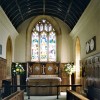A writer commenting on Powerstock in the early 19th century leaves us with a picture of a poor village at a junction where four lanes meet. He describes the place as consisting of three or four farmhouses, the parsonage, an alehouse and some dilapidated cottages. The church and churchyard are said to be “out of repair” but contrast favourably with the miserable cottages and the filthy heaps before the doors, and the pigsties and ill-kept farmyards. Our distant writer comments that very few people besides the union doctor or a chance friend of the vicar ever came here.
Elizabeth Gale buried her 40 year-old husband at Powerstock on the 14th of January 1839. It had been a childless marriage and there was nothing, except perhaps public opinion, to stop her accepting an invitation from John Hounsell to go away with him for a few days. They went to Radipole where a proposal of marriage was made and accepted and the couple were intimate. As we saw in part one of our story it was their eagerness to marry that attracted suspicion.
Events now take us to Dorchester where John Hounsell was charged with the wilful murder of his wife and was tried on July 23rd at the Summer Assizes of 1839, before Mr Justice Erskine.
Doctors who conducted the post-mortem on the bodies of Mary Hounsell and James Gale told the Coroner that Mary Hounsell had died from a large dose of arsenic. We know that John Hounsell used arsenic in his work and we might reasonably assume he had some knowledge of its properties, so, if guilty, why would he have used so much? During the trial it came out that the arsenic was kept in a jar on a shelf over the couple’s bed. Mr Stock, defending, argued successfully that there was no evidence that John Hounsell had administered the arsenic. He did not dispute the opinion of the “medical gentlemen” as to the cause of death but argued that “the evidence was not such as to connect the defendant with administering the arsenic.” After Mr Justice Erskine had “most ably and impressively summed up” it took the jury just a few moments of deliberation to return a verdict of not guilty and a relieved John Hounsell found himself on the pavement of High West Street, Dorchester, as a free man.
If John Hounsell did not administer the poison and Mary did not take her own life was there anyone else with motive and opportunity? Is it conceivable Elizabeth Gale acted alone? Did John Hounsell and Elizabeth Gale conspire together to do away with their spouses? Later events clearly show their relationship was more than that of good neighbours, giving Elizabeth motive. But Elizabeth Gale can speak for herself: this is what she told the court when called as a witness:
“I am a widow living at Powerstock. James Gale, my husband, died about old Christmas last. I knew Mary Hounsell and her husband. I attended Mary Hounsell on the Monday of the week in which she died. Earlier in her illness I made a sweat for her. The prisoner was present. She was taken ill on the Sunday, and the sweat was made the Tuesday after, and on the Monday after that I was again called for. Her husband carried the sweat to her bedroom. I afterwards went upstairs; her husband was there. She said she was sick and could not take any more; she was vomiting. After Mr Hounsell, the surgeon came. On Friday I sat up with her all night. Mr Hounsell sent medicines for her, in taking which she vomited every time. On Sunday she was better; on Monday morning I went and made some broth, and afterwards gave her some tea, bread and butter. She died about twelve on Thursday night. I was not present, but present just before; her husband was then in the kitchen.”
“Prisoner sent me to Mr Roper, a chemist at Bridport, before the illness of his wife, with a note. Mr Roper gave me a small parcel in paper, which I put in my pocket. The paper broke in my pocket, and some of its contents came out. I afterwards gave the parcel to the prisoner. The day on which Mary Hounsell died I eat some pears which I had in my pocket when I fetched the parcel, and they made me sick all the afternoon and night. There was no peculiar taste in the pears. I examined my pocket the next morning, and found some white powder stuff, which I shook out near the window. I afterwards saw the prisoner. I asked him what was in the parcel I brought from Bridport. He told me it was poison.
After my husband’s death I was intimate with the prisoner and went to Radipole with him. This might be a fortnight after my husband’s death. Prisoner had made me an offer of marriage; banns were published.”
Under cross examination Elizabeth Gale also told the court: “The sweat was made at the desire of the deceased. It was made of rosemary hyssop and beer. Prisoner is a cattle doctor and people went to him for such complaints as the itch. At the head of Mary Hounsell’s bed was a shelf, on which I saw bottles and pots and boxes. Prisoner and his wife lived very happily together, and during her illness he was very kind and attentive to her. Mr Hounsell [the surgeon] was sent for at his desire. Prisoner had frequently sent me to the druggist’s with notes for parcels.”
Other witnesses were called including Henry Mintern, Elizabeth Gale’s father, who corroborated parts of her evidence and Elizabeth Biles stated she knew the prisoner and the deceased woman. He was kind to her, and, against her own wish had sent for a doctor to attend her.
John Roper stated that he was a chemist at Bridport, and that he delivered to the coroner a note, found on his file, from the prisoner. He produced two samples of the arsenic and corrosive sublimate sold in his shop. Under cross examination he said “I have never known arsenic used for cutaneous diseases. Country people sometimes purchase small quantities.”
Elizabeth Gale was re-called: “The parcel I had from the druggist was like this [arsenic] I fancy the powder I had in my pocket was rather rougher than this. It was gritty like this [corrosive sublimate], but not so rough.”
James Daniel, a surgeon, of Beaminster, stated that he attended Elizabeth Gale after her eating pears “I should say distinctly the symptoms were those of poison from arsenic. There is no particular taste about arsenic. Corrosive sublimate has a peculiar burning and coppery taste.”
The prosecution case was poorly presented by Mr Bond and Mr Butt appearing for the Crown, and at the time it was thought they should have argued more strongly against the notion that this was a suicide. The Dorset County Chronicle commented “the case was not well got up and, in spite of very strong evidence of his guilt, the jury acquitted him.”
If John Hounsell was innocent he had plenty of time between February and July to speculate about how his wife came to die with sufficient arsenic in her stomach to kill six people. John Housell did not marry Elizabeth Gale after his acquittal.











